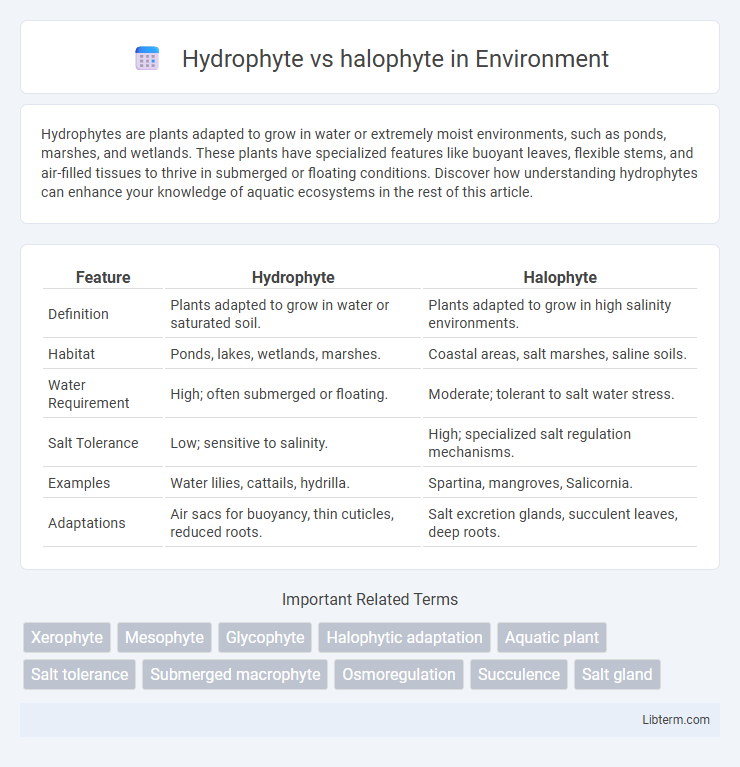Hydrophytes are plants adapted to grow in water or extremely moist environments, such as ponds, marshes, and wetlands. These plants have specialized features like buoyant leaves, flexible stems, and air-filled tissues to thrive in submerged or floating conditions. Discover how understanding hydrophytes can enhance your knowledge of aquatic ecosystems in the rest of this article.
Table of Comparison
| Feature | Hydrophyte | Halophyte |
|---|---|---|
| Definition | Plants adapted to grow in water or saturated soil. | Plants adapted to grow in high salinity environments. |
| Habitat | Ponds, lakes, wetlands, marshes. | Coastal areas, salt marshes, saline soils. |
| Water Requirement | High; often submerged or floating. | Moderate; tolerant to salt water stress. |
| Salt Tolerance | Low; sensitive to salinity. | High; specialized salt regulation mechanisms. |
| Examples | Water lilies, cattails, hydrilla. | Spartina, mangroves, Salicornia. |
| Adaptations | Air sacs for buoyancy, thin cuticles, reduced roots. | Salt excretion glands, succulent leaves, deep roots. |
Overview of Hydrophytes and Halophytes
Hydrophytes are plants adapted to grow in water-saturated environments such as ponds, lakes, and wetlands, featuring specialized structures like aerenchyma for oxygen transport and floating leaves. Halophytes thrive in high-salinity habitats such as salt marshes and coastal regions, exhibiting salt tolerance mechanisms including salt excretion glands and succulence. Both plant types demonstrate unique physiological and anatomical adaptations that enable survival in their respective extreme aquatic and saline ecosystems.
Key Definitions: Hydrophytes vs Halophytes
Hydrophytes are aquatic plants adapted to grow in freshwater environments with low salt concentrations, possessing specialized structures like aerenchyma for oxygen transport. Halophytes thrive in saline soils or water, exhibiting salt tolerance mechanisms such as salt excretion glands or succulence to manage osmotic stress. Both hydrophytes and halophytes demonstrate unique physiological and morphological adaptations that enable survival under distinct environmental salinity conditions.
Distinctive Habitat Requirements
Hydrophytes thrive in freshwater environments such as ponds, lakes, and marshes, where they are adapted to saturated soil conditions with low oxygen availability. Halophytes, in contrast, are specialized to grow in saline habitats like salt marshes, mangroves, and coastal areas where high salt concentration limits freshwater plant growth. The unique physiological mechanisms of hydrophytes and halophytes enable them to overcome osmotic stress and ion toxicity in their respective distinct habitats.
Morphological Adaptations: Comparison
Hydrophytes exhibit morphological adaptations such as thin cuticles, large air spaces (aerenchyma) in leaves and stems, and reduced root systems to facilitate buoyancy and efficient gas exchange in aquatic environments. Halophytes, on the other hand, develop specialized salt-excreting glands, succulence for water storage, and thickened cuticles to minimize water loss under saline conditions. These contrasting adaptations enable hydrophytes to thrive in water-saturated habitats while halophytes are optimized for saline, arid environments.
Physiological Strategies for Survival
Hydrophytes utilize physiological adaptations such as aerenchyma tissue for efficient oxygen transport and specialized stomata to manage waterlogged environments, ensuring survival in aquatic habitats. Halophytes employ salt regulation mechanisms including salt gland secretion and ion compartmentalization within vacuoles to mitigate osmotic stress in saline conditions. These divergent strategies enable hydrophytes and halophytes to thrive by optimizing gas exchange and ion homeostasis respective to their ecosystems.
Examples of Common Hydrophytes
Common hydrophytes such as water lilies (Nymphaea spp.), cattails (Typha spp.), and duckweeds (Lemna spp.) thrive in aquatic environments with abundant water availability. These plants exhibit specialized adaptations like air-filled tissues for buoyancy and extensive root systems to anchor in soft sediments. Unlike halophytes, which are salt-tolerant plants found in saline habitats like mangroves (Rhizophora spp.) and saltbushes (Atriplex spp.), hydrophytes are adapted specifically to freshwater or low-salinity conditions.
Examples of Common Halophytes
Common halophytes such as Salicornia europaea (glasswort), Spartina alterniflora (smooth cordgrass), and Atriplex halimus (saltbush) thrive in saline environments like salt marshes and coastal areas. These plants exhibit specialized adaptations, including salt excretion glands and succulent leaves, enabling survival in high-salinity conditions. In contrast, hydrophytes like Nymphaea alba (white water lily) and Eichhornia crassipes (water hyacinth) are adapted to freshwater habitats, lacking salt tolerance mechanisms.
Ecological Roles and Significance
Hydrophytes, adapted to freshwater environments, play a crucial role in water purification and provide habitat for aquatic organisms, maintaining biodiversity in wetlands. Halophytes thrive in saline soils and salt marshes, stabilizing shorelines and preventing soil erosion while supporting specialized wildlife adapted to high salt conditions. Both plant types contribute significantly to ecosystem resilience by promoting nutrient cycling and offering critical services in their respective habitats.
Importance in Environmental Management
Hydrophytes and halophytes play critical roles in environmental management by enhancing ecosystem stability and water quality. Hydrophytes, adapted to aquatic environments, improve oxygenation and serve as natural biofilters, reducing pollutants in freshwater habitats. Halophytes thrive in saline soils and are essential for soil reclamation, preventing desertification and supporting coastal ecosystem resilience.
Hydrophyte vs Halophyte: Summary Table
Hydrophytes thrive in freshwater environments with low salt concentrations, exhibiting adaptations like aerenchyma and floating leaves, while halophytes tolerate high salinity soils through salt-excreting glands and succulent tissues. The summary table highlights differences in habitat, salt tolerance, root structure, and water absorption mechanisms, distinguishing hydrophytes' reliance on abundant water from halophytes' strategies to manage osmotic stress. These physiological and structural variations are crucial for their survival in contrasting aquatic and saline ecosystems.
Hydrophyte Infographic

 libterm.com
libterm.com